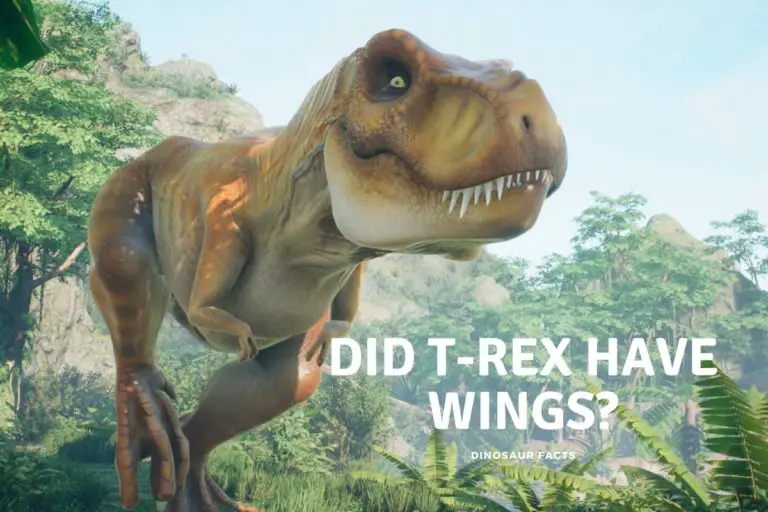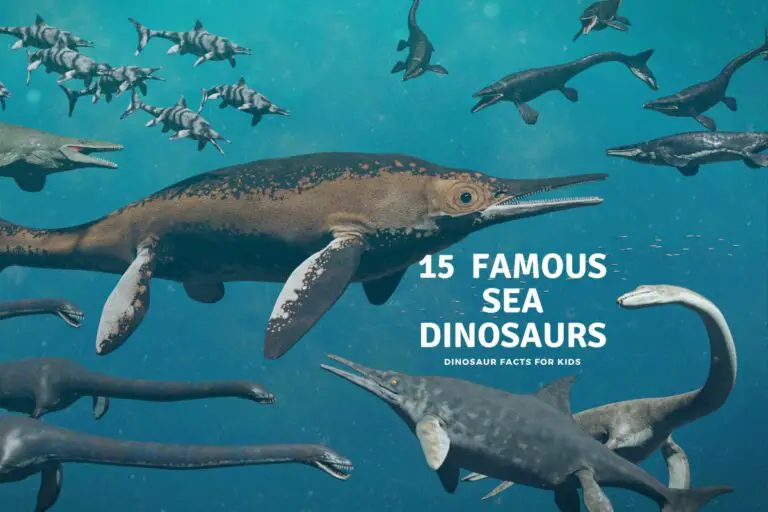What Were The Largest Flying Dinosaurs?
A Google search of “What Were The Largest Flying Dinosaurs?” incorrectly points out the Pterosaurs (flying reptiles) as the family containing the largest flying dinosaur species. This is incorrect as Pterosaurs and Dinosaurs share a common ancestor but are two distinct species. This distinction is almost as different as how large they were. We will take a look at some of the largest flying dinosaurs below.
Sinornithosaurus was the largest of the “flying dinosaurs” to our knowledge in the fossil record. The giants of the skies during the time were flying lizards called pterosaurs. Quetzalcoatlus, named after the Aztec feathered serpent god, Quetzalcoatl was the largest pterosaur.
The therapods are a family of dinosaurs that included Tyrannosaurus Rex and Velociraptors. Some claim these two-legged bird-like dinosaurs to be the ancestors of modern birds.
Let’s pursue this debate and decide for ourselves whether there were the largest flying dinosaurs before the mass extinction event 65 million years ago.
Were Flying Dinosaurs Alive Before 65 Million Years Ago?
Bird-like dinosaurs did exist about 120 million to 125 million years ago during the Early Cretaceous period and were part of the Dromaesaurids. They were four-winged feathered dinosaurs that had developed the ability to glide from tree to tree but were not capable of powered flight.
None of these dinosaurs grew to impressive size and were similar in size to modern birds like crows and storks. Although they had evolved feathers on their front and rear legs, it does not seem that they had the ability of meaningful powered flight.
The Dromaesaurids lived in forests where they preyed on small lizards, insects, and fish. They climbed trees and then used their primitive wings to glide from tree to tree.
Evolutionary Paleontologists speculate that these winged gliding dinosaurs became extinct. Other of this group evolved into the fearsome Velociraptor, Dakotaraptor, and Deinonychus.
The largest and most interesting of these Microraptors were Sinornithosaurus which had a 6-foot wingspan and weighed 6.6 pounds. The Sinornithosaurus had teeth that were very similar to venomous fangs and were thought to have been venomous.
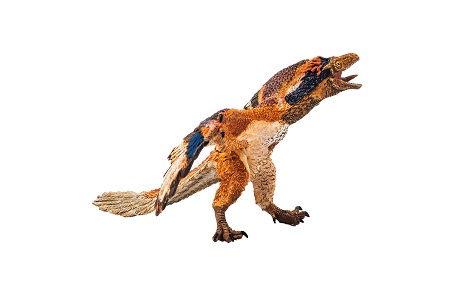
Archaeopteryx lived 150 million years ago and is the oldest bird-like dinosaur ever to appear in the fossil records. The name, Archaeopteryx means “Old Wing,” and many fossils of this dinosaur have been found in Germany.
Archaeopteryx is believed to be the oldest bird-like ancestor of modern birds and grew to a wingspan of 4.5 feet and a weight of 1.8 pounds, similar in size to the modern-day crow.
Compared to the Wandering Albatross, the largest flying bird alive today, these ancient bird-like dinosaurs were tiny. The albatross has a wingspan of 12 feet and can weigh as much as 28 pounds. It can remain in the sky for several days and consume less energy while gliding in the air than on the ground.
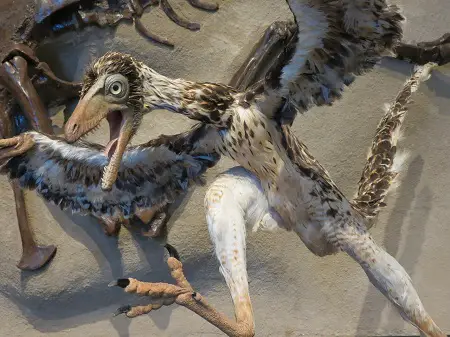
Table 1: Size Difference between Flying Dinosaurs and pterosaurs.
| Pterosaurs | Wing Span (ft) | Height (ft) | Weight (lbs) | Powered Flight |
| Quetzalcoatlus | 40 | 18 | 600 | Yes |
| Hatzegopteryx | 40 | 20 | 550 | Yes |
| Tropeognatus | 28 | 8 | 220 | Yes |
| Arambourgiana | 36 | 15 | 550 | Yes |
| Geosternbergia | 24 | 6 | 200 | Yes |
| Dinosaurs | ||||
| Microraptor | 3 | 1 | 2.2 | Downward Gliding |
| Changyuraptor | 7 | 3 | 9 | Downward gliding |
| Sinornithosaurus | 6 | 4 | 6.6 | Downward gliding |
| Archaeopteryx | 4.5 | 1.5 | 1.8 | Powered maybe |
| Wandering Albatross | 12 | 4 | 28 | Yes |
The Largest Flying Animals Ever To Have Lived
The Pterosaurs or flying reptiles are related to dinosaurs as both species evolved from reptiles. Pterosaurs are not dinosaurs, and this error often leads to the giant flying Pterosaurs being quoted by search engines as dinosaurs.
Calling a pterosaur a dinosaur is like calling a marsupial a human. Marsupials and humans are both mammals, but they are distinctly different species. The giant flying pterosaurs that filled the skies during the Jurassic and Cretaceous periods are the largest flying animals ever to have lived.
Quetzalcoatlus and Hatzegopteryx were the largest of the flying pterosaurs, with each boasting a wingspan as big as 40 feet, the size of a modern fighter plane. They stood as tall as a Giraffe but weighed only a quarter, 550 to 600 pounds when fully grown.
Quetzalcoatlus lived in North America 75 million to 66 million years ago, and the largest specimen ever found was named Quetzalcoatlus Northrop. Hatzegopteryx lived in Europe during the same period.
Geosternbergia was a predecessor to Quetzalcoatlus in North America and lived 88 million to 85 million years ago during the Cretaceous period. It had a wingspan of 24 feet and weighed as much as 200 pounds when fully grown.
Tropeognatus or “Keel Jaw” lived in South America during the Early Cretaceous and had a wingspan of 28 feet and a full-grown weight of 220 pounds. Tropeognatus holds the record as the largest pterosaur ever found in the southern hemisphere.
Arambourgiania was a contemporary of Quetzalcoatlus and Hatzegopteryx but lived in Asia and the Middle East. Arambourgiana had a wingspan of 36 feet and grew to a weight of 550 pounds.
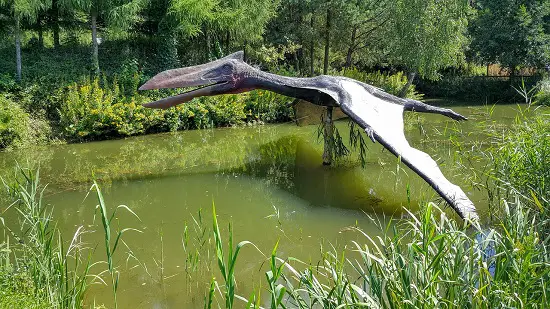
These giant pterosaurs had all developed a technique for using their powerful hind legs to launch themselves into the air and then fly using their huge wings. The hollow bone structure of their skeletons made them light enough yet strong enough for powered flight.
Like the modern-day Albatros, the giant pterosaurs could fly into the thermal air currents and spend days aloft. They were capable of flying 10,000 miles and would thus have been able to match modern commercial airplanes for reach.
The confusion that is still widely persistent that the pterosaurs were part of the dinosaur family is perhaps due to movies such as Jurassic Park, in which they appear alongside other giant dinosaurs to strike terror into audiences.
Even a Google search for the “Largest Flying Dinosaurs” incorrectly results in the pterosaurs being named. Flying dinosaurs did exist and evolved alongside birds during the Cretaceous period. None of them grew to anywhere near the size of the pterosaurs.
We also have an article on the largest pterodactyls here on the site as well.
We also have an article on the friendliest dinosaurs as well, if you wanted to check it out.
If you are looking for the smallest dinosaurs ever to live then we have this article here on the site as well.
Conclusion
The largest animals ever to have developed the ability to fly were the Pterosaurs, distant cousins of the dinosaurs. Quetzalcoatlus and Hatzegopteryx were the largest of the flying pterosaurs, with the consensus that Quetzalcoatlus was slightly larger.
Archaeopteryx was the first dinosaur to have evolved feathered wings and was likely only able to glide and not of powered flight. Not much larger than the modern-day crow Archaeopteryx is recognized as the oldest of all the bird-like dinosaurs ever to have lived.
References:
- https://www.birdlife.org/news/2021/12/21/its-official-birds-are-literally-dinosaurs-heres-how-we-know
- https://www.smithsonianmag.com/science-nature/why-a-pterosaur-is-not-a-dinosaur-87082921/
- https://www.smithsonianmag.com/smart-news/new-studies-unveil-details-about-the-largest-flying-creature-to-ever-live
- https://www.nhm.ac.uk/discover/news/2021/december/largest-ever-flying-animal-behaved-like-giant-heron.html
- https://fossil.fandom.com/wiki/Hatzegopteryx
- https://medium.com/swlh/just-how-big-was-the-largest-flying-dinosaur-huge-c71f602cccd8
- https://youtu.be/9Rbde7lwcUo – Top 5 Pterosaurs
- https://youtu.be/iO-cPa7wNos – Microraptors and the Very Bird Like Dinosaurs
- https://www.youtube.com/watch?v=NeneVmqhJPE – Hatzegopteryx vs Quetzalcoatlus 2019
Hi, I am Roy Ford a General Studies and English Teacher who has taught all over the world. What started as a fossil collection became a great way to teach, motivate and inspire students of all ages and all over the world about dinosaurs and from that and children’s love of dinosaurs came the site dinosaur facts for kids, a resource for all ages.




